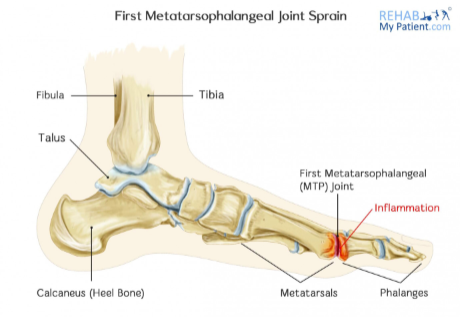
Common Injuries in the Foot
Fractures
Mechanism of Injury (MOI): caused by direct trauma from contact with the ground or an opponent
Fractures in specific areas of the foot that occur frequently are given particular names to designate the location of the injury
Example- Jones Fracture: most common acute injury to the foot, occurs at the proximal base of the fifth metatarsal
Signs and Symptoms (S&S)
Pain and swelling at injury site
Possible deformity of the bone
Discoloration or redness
Athlete heard a pop or snap
Athlete unable to bear weight
Hesitation to ambulate
Treatment
Depend on the location of injury
Phalanx Fracture vs Metatarsal or Tarsal bone
Immobilization: walking boot, crutches (NWB)
Rehabilitation
Stress Fracture
MOI: overuse
Can occur in any bone in the foot but most common in the metatarsals (2nd and 5th)
March Fracture: stress fx to the 2nd metatarsal (high occurrence rate in the military during basic training
S&S:
Gradual onset of pain (achy)
Sensation similar to a rock in their shoe while running or walking
Can lead to Stress Reactions: bone attempts to repair healthy bone tissue to protect itself.
This increases the stress fx stage as bone becomes weaker and eventually breaks down
Treatment
Immobilization
Rest to bone stimulation
Surgical intervention
Orthotics to long term reduce forces or correct mechanics
Rehabilitation
Arch Strain/Sprain
MOI: Hyperextension of the midfoot, often resulting from contact with an uneven surface or twisting motion during running
Longitudinal arch most common one sprained/strained
Damage to the muscles, ligaments and/or fascia that assist in the formation of the arch
Because multiple structures are damaged we use sprain and strain
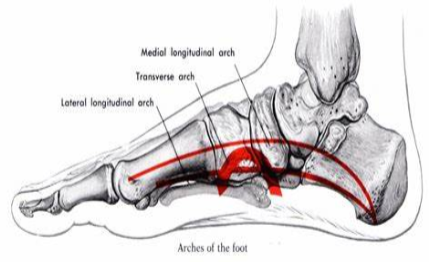
S&S:
Pain and tenderness over injury site
Swelling (usually seen on medial aspect of arch)
Pain with running and cutting
Treatment:
RICE
Arch tape, orthotics
Return to Play (RTP)
Spring Ligament Sprain
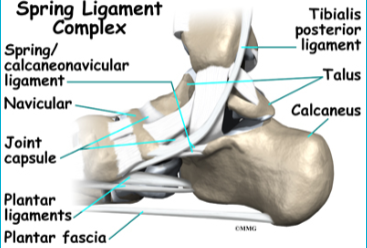
Plantar Calcaneonavicular Ligament (Spring Ligament)
Important component of the longitudinal arch and assists in the shock absorption and maintaining the integrity of the arch
MOI: running on uneven surfaces and stepping in holes or divots
S&S
Pain and tenderness distal to the heel of the foot on the medial aspect of the arch
Pain with weight bearing
Slight swelling over injury site
Treatment:
RICE
Orthotics or padding to provide support
RTP as tolerated
Plantar Fasciitis
Plantar Fascia: fibrous tissue on the bottom of the foot that runs the length of the foot to help strengthen the arch complex
The fascia can become inflamed as a result to chronic stress.
The initial stress causing the fascia to tighten, which decreases range of motion (ROM) and increases the stress on the tissue.
As the stress increases, the tightness and inflammation increases causing more damage to the fascia.

MOI: overuse/chronic, anatomy
S&S
Pain most often at the distal aspect of the heel on the lateral side
Pain that is most severe with the first steps out of bed in the morning
Tightness and decreased ROM at the midfoot
Slight swelling at injury site
Treatment:
Ultrasound therapy
Ice massage
Friction massage (tennis or lacrosse ball) -> break down scar tissue
Stretching
Medication
Night Splint (keep dorsiflexed position)
Heel Contusion
MOI: stepping on a hard object or jumping from a high height
Injury may also develop chronically from repetitive compression (worn down shoes without proper cushioning)
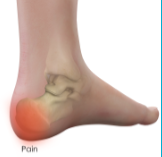
S&S
Point tender on heel
Slight discoloration
Pain with ground contact
Treatment
RICE
Heel cup or heel taping when playing sports
X-ray to rule out fx
Turf Toe
Sprain of the first metatarsophalangeal (MTP) joint
MOI: hyperextension or hyperflexion motion of the joint
S&S
Pain at 1st MTP joint
Pain with flexion or extension of 1st MTP
Pain and discomfort with running, especially push off
Slight swelling and discoloration
Treatment
RICE
Referral to physician to rule out fx
Turf toe tape or steel insole to decrease motion
Bunion and Bunionette
Bunion: protrusion medially from 1st metatarsal head, inflammation of the synovial bursa resulting in the enlargement of the joint and lateral displacement of the toe
Bunionette: similar injury expect it occurs at the 5th metatarsal
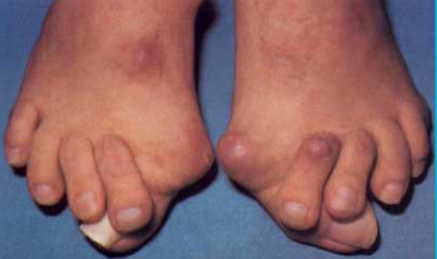
MOI: chronic and increases in size over time, 1st metatarsal head moving medially causing inflammation in surrounding tissue and forcing the first toe in the opposite direction
S&S
Pain, especially with shoes on
Redness and swelling
Obvious protrusion of the 1st or 5th metatarsal with opposite movement of the associated toes
Treatment of Bunions/Bunionettes
Ice
Shoe change
Surgical intervention
Padding
Common Injuries in the Foot
Fractures
Mechanism of Injury (MOI): caused by direct trauma from contact with the ground or an opponent
Fractures in specific areas of the foot that occur frequently are given particular names to designate the location of the injury
Example- Jones Fracture: most common acute injury to the foot, occurs at the proximal base of the fifth metatarsal
Signs and Symptoms (S&S)
Pain and swelling at injury site
Possible deformity of the bone
Discoloration or redness
Athlete heard a pop or snap
Athlete unable to bear weight
Hesitation to ambulate
Treatment
Depend on the location of injury
Phalanx Fracture vs Metatarsal or Tarsal bone
Immobilization: walking boot, crutches (NWB)
Rehabilitation
Stress Fracture
MOI: overuse
Can occur in any bone in the foot but most common in the metatarsals (2nd and 5th)
March Fracture: stress fx to the 2nd metatarsal (high occurrence rate in the military during basic training
S&S:
Gradual onset of pain (achy)
Sensation similar to a rock in their shoe while running or walking
Can lead to Stress Reactions: bone attempts to repair healthy bone tissue to protect itself.
This increases the stress fx stage as bone becomes weaker and eventually breaks down
Treatment
Immobilization
Rest to bone stimulation
Surgical intervention
Orthotics to long term reduce forces or correct mechanics
Rehabilitation
Arch Strain/Sprain
MOI: Hyperextension of the midfoot, often resulting from contact with an uneven surface or twisting motion during running
Longitudinal arch most common one sprained/strained
Damage to the muscles, ligaments and/or fascia that assist in the formation of the arch
Because multiple structures are damaged we use sprain and strain

S&S:
Pain and tenderness over injury site
Swelling (usually seen on medial aspect of arch)
Pain with running and cutting
Treatment:
RICE
Arch tape, orthotics
Return to Play (RTP)
Spring Ligament Sprain

Plantar Calcaneonavicular Ligament (Spring Ligament)
Important component of the longitudinal arch and assists in the shock absorption and maintaining the integrity of the arch
MOI: running on uneven surfaces and stepping in holes or divots
S&S
Pain and tenderness distal to the heel of the foot on the medial aspect of the arch
Pain with weight bearing
Slight swelling over injury site
Treatment:
RICE
Orthotics or padding to provide support
RTP as tolerated
Plantar Fasciitis
Plantar Fascia: fibrous tissue on the bottom of the foot that runs the length of the foot to help strengthen the arch complex
The fascia can become inflamed as a result to chronic stress.
The initial stress causing the fascia to tighten, which decreases range of motion (ROM) and increases the stress on the tissue.
As the stress increases, the tightness and inflammation increases causing more damage to the fascia.

MOI: overuse/chronic, anatomy
S&S
Pain most often at the distal aspect of the heel on the lateral side
Pain that is most severe with the first steps out of bed in the morning
Tightness and decreased ROM at the midfoot
Slight swelling at injury site
Treatment:
Ultrasound therapy
Ice massage
Friction massage (tennis or lacrosse ball) -> break down scar tissue
Stretching
Medication
Night Splint (keep dorsiflexed position)
Heel Contusion
MOI: stepping on a hard object or jumping from a high height
Injury may also develop chronically from repetitive compression (worn down shoes without proper cushioning)

S&S
Point tender on heel
Slight discoloration
Pain with ground contact
Treatment
RICE
Heel cup or heel taping when playing sports
X-ray to rule out fx
Turf Toe
Sprain of the first metatarsophalangeal (MTP) joint
MOI: hyperextension or hyperflexion motion of the joint
S&S
Pain at 1st MTP joint
Pain with flexion or extension of 1st MTP
Pain and discomfort with running, especially push off
Slight swelling and discoloration
Treatment
RICE
Referral to physician to rule out fx
Turf toe tape or steel insole to decrease motion
Bunion and Bunionette
Bunion: protrusion medially from 1st metatarsal head, inflammation of the synovial bursa resulting in the enlargement of the joint and lateral displacement of the toe
Bunionette: similar injury expect it occurs at the 5th metatarsal

MOI: chronic and increases in size over time, 1st metatarsal head moving medially causing inflammation in surrounding tissue and forcing the first toe in the opposite direction
S&S
Pain, especially with shoes on
Redness and swelling
Obvious protrusion of the 1st or 5th metatarsal with opposite movement of the associated toes
Treatment of Bunions/Bunionettes
Ice
Shoe change
Surgical intervention
Padding
 Knowt
Knowt